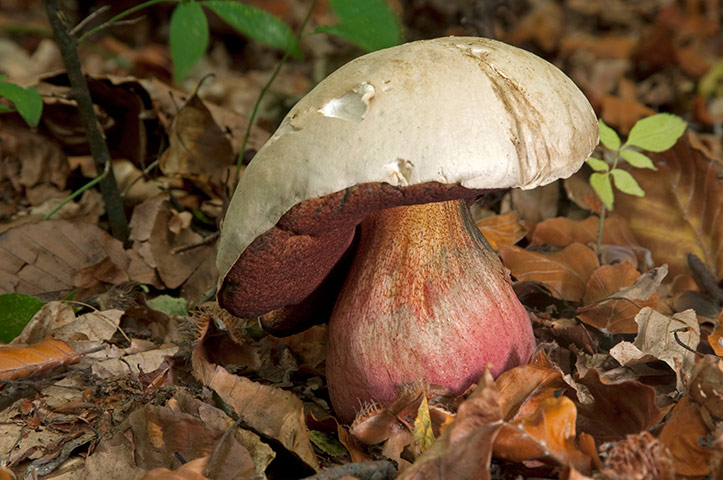Devil's Bolete: Red Data Book of Armenia

Category. EN – Endangered.
Brief description. Cap is 8–25 cm across whitish–grey, pulvinate, even, fleshy, velvety, smooth, dry, sometimes slimy after rain. The lower part of the cap, which is yellow–green at first, is spongy–like with small pores, has redish–olive colouring with age. Flesh is white, whitish, firm, when cut at first turns red, then blue with unpleasant smell and sweet taste. Stipe is 6–9 x 5–11 µm, yellow–redish, with conspicuous dark red net, central. It is clavate, equally widened towards the base. Spore print is olive–coloured. Spores are 11–14 x 5–5 µm, fusiform, smooth, olive–coloured.
Distribution. Generally in Europe, Asia, Northern America, Southern Caucasus (Georgia, Armenia). In Armenia it is rarely met mainly in unique individuals. It is found in Ijevan floristic region – "Dilijan" National Park; Zangezur floristic region – in the surroundings of Goris city; Meghri floristic region – in the village Arevik.
Ecological, biological and phytocenological peculiarities. It is met on the soil, in mixed forests on the altitude of 600–1500 m above sea level from July to September. Mycorrhizal fungi, with coniferous and broad– leaved trees, generally with oak and beech trees. It is a poisonous species.
Main factors of endangering. Intensive forest exploitation, degression of forest areas caused by uncontrolled fellings.
Nature conservation measures. In Armenia it is conserved in corresponding ecosystems of "Dilijan" National Park. It is necessary to carry out works for discovering new habitats.
Suggestions
 The Ministry of Environment sent a letter international partners to draw their attention to the real danger of environmental disasters as a result of Azerbaijan's large-scale aggression towards the territory of Armenia
The Ministry of Environment sent a letter international partners to draw their attention to the real danger of environmental disasters as a result of Azerbaijan's large-scale aggression towards the territory of Armenia
 Vicia pisiformis: Red Data Book of Armenia
Vicia pisiformis: Red Data Book of Armenia
 Vavilovia formosa: Red Data Book of Armenia
Vavilovia formosa: Red Data Book of Armenia
 Trigonella capitata: Red Data Book of Armenia
Trigonella capitata: Red Data Book of Armenia
 Trigonella astroides: Red Data Book of Armenia
Trigonella astroides: Red Data Book of Armenia












